Geoboard Shapes
May 03, 2015
A geoboard (of order N) is a square board with equally-spaced pins protruding from the surface, representing an integer point lattice for coordinates 0 ≤ x,y ≤ N.
John begins with a pinless geoboard. Each position on the board is a hole that can be filled with a pin. John decides to generate a random integer between 1 and N+1 (inclusive) for each hole in the geoboard. If the random integer is equal to 1 for a given hole, then a pin is placed in that hole.
After John is finished generating numbers for all (N+1)2 holes and placing any/all corresponding pins, he wraps a tight rubberband around the entire group of pins protruding from the board. Let S represent the shape that is formed. S can also be defined as the smallest convex shape that contains all the pins.

The above image depicts a sample layout for N = 4. The green markers indicate positions where pins have been placed, and the blue lines collectively represent the rubberband. For this particular arrangement, S has an area of 6. If there are fewer than three pins on the board (or if all pins are collinear), S can be assumed to have zero area.
Let E(N) be the expected area of S given a geoboard of order N. For example, E(1) = 0.18750, E(2) = 0.94335, and E(10) = 55.03013 when rounded to five decimal places each.
Calculate E(100) rounded to five decimal places.
Written by gamwe6 who lives and works in San Francisco building useful things. You should follow him on Twitter